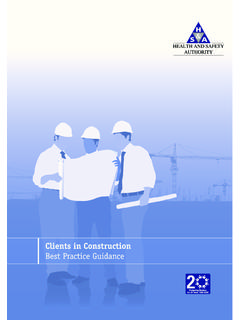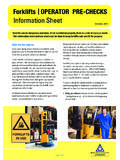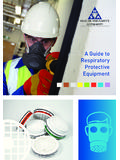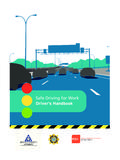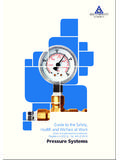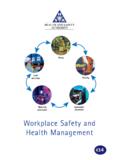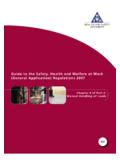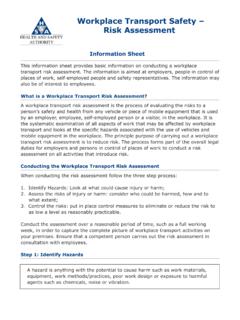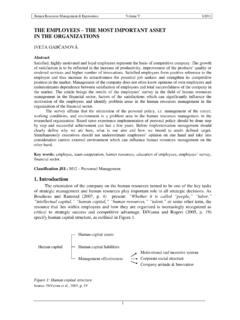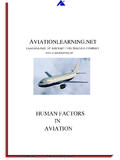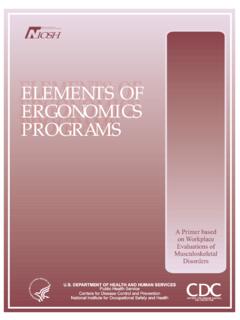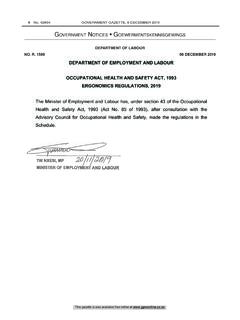Transcription of Ergonomics in the Workplace - Health and Safety Authority
1 Ergonomics in the WorkplaceERGONOMICS IN THEWORKPLACEE rgonomics in theWorkplace1 Ergonomics IN THEWORKPLACE2 IntroductionThe purpose of this short guide is to provide information to the readeron the subject of Ergonomics . It also provides guidance on where tosource further information. It is not within the bounds of this guidanceto discuss in detail all the main aspects of knowledge in the field ofErgonomics. However efforts will be made to give the reader anunderstanding of different ergonomic principles aswell as anappreciation of relevant and useful literature and textbooks, whichcover the subject of Ergonomics in more detail. The guidance is designed to assist those who deal with Ergonomicissues in a Workplace setting and these include architects, designers,engineers, manufacturers, suppliers, contractors, Health and safetyprofessionals, Safety representatives, employers and employees.
2 Ergonomics applies information about human behaviour,abilities and limitations and other characteristics to thedesign of tools, machines, tasks, jobs and environmentsfor productive, safe, comfortable and effective humanuse (McCormick and Saunders 1993). A number of factors play a role in Ergonomics ; these include bodyposture and movement (sitting, standing, lifting, pulling and pushing),and environmental factors (noise, lighting, temperature, humidity).(Dul et al 1993).THE IMPACT OF Ergonomics ON WORKPLACEDESIGNThe goal of Ergonomics is to provide maximum productivity withminimal cost; in this context cost is expressed as the physiological orhealth cost to the worker. In a Workplace setting there are seldom alarge number of tasks that exceed the capabilities of most of the workforce.
3 There may be jobs that will include a specific task that requiresERGONOMICS IN THEWORKPLACE extended reaches or overhead work that cannot be sustained for longperiods, by using ergonomic principles to design these tasks; morepeople should be able to perform the job without the risk of injury. Ergonomics has already been defined and its primary focus is on thedesign of work activity that suits the person in that it takes account oftheir capabilities and limitations. Matching the requirements of a jobwith the capabilities of the worker is the approach to be adopted inorder to reduce the risks of musculoskeletal injuries resulting fromhandling materials Ergonomics emphasises the prevention of work relatedmusculoskeletal disorders through recognising, anticipating andreducing risk factors in the planning stages of new systems of work orworkplaces.
4 In effect, to design operations that ensures proper selectionand use of tools, job methods, workstation layouts and materials thatimpose no undue stress and strain on the worker. Additional costs areincurred in redesigning or modifying work processes therefore it is morecost effective to reduce risk factors at the design proactive approach to Ergonomics will ensure that: Designers will receive training in Ergonomics and haveappropriate information and guidelines regarding risk reduction Decision-makers planning new work processes should haveknowledge of Ergonomics principles that contribute to thereduction or elimination of risk. Design strategies emphasise fitting job demands to thecapabilities and limitations of workers.
5 For example, for tasksrequiring heavy materials handling, use of mechanical assistdevices to reduce the need for manual handling would bedesigned into the process Other aspects of design should be considered including loaddesign, layout of the Workplace to allow for ease of access whenusing mechanical aids and eliminating unnecessary liftingactivities. 3 Ergonomics IN THEWORKPLACEERGONOMIC PRINCIPLES THAT CONTRIBUTE TOGOOD Workplace DESIGNThe goal for the design of workplaces is to design for as many peopleas possible and to have an understanding of the ergonomic principlesof posture and movement which play a central role in the provision ofa safe, healthy and comfortable work environment. Posture andmovement at work will be dictated by the task and the Workplace , thebody s muscles, ligaments and joints are involved in adopting posture,carrying out a movement and applying a force.
6 The muscles providethe force necessary to adopt a posture or make a movement. Poorposture and movement can contribute to local mechanical stress onthe muscles, ligaments and joints, resulting in complaints of the neck,back, shoulder, wrist and other parts of the musculoskeletal principles provide possibilities for optimising tasks in theworkplace These principles are summarised in Table 1 below:TABLE 1: 4 ERGONOMICPRINCIPLEDESCRIPTIONJ oints must bein a neutralpositionIn the neutral position themuscles and ligaments, whichspan the joints, are stretchedto the least possible extentKeep workclose to thebodyIf the work is too far from thebody, the arms will beoutstretched and the trunkbent over forwardsERGONOMICS IN THEWORKPLACE5 ERGONOMICPRINCIPLEDESCRIPTIONA void bendingforwardThe upper part of the body ofan adult weighs about 40kgon average.
7 The further thetrunk is bent forwards, theharder it is for the musclesand ligaments of the back tomaintain the upper body inbalanceA twisted trunkstrains the backTwisted postures of the trunkcause undesirable stress to thespineAlternateposture as wellas movementsNo posture or movementshould be maintained for along period of postures andrepetitive movements excessivereachesIt is necessary to limit theextent of forward andsideways reaches to avoidhaving to bend over or twistthe trunkAvoid carryingout tasksabove shoulderlevelThe hands and elbows shouldbe well below shoulder levelwhen carrying out a task Ergonomics IN THEWORKPLACE6 Ergonomics AND IRISH LEGISLATIONThe Manual Handling of Loads RegulationMany of the ergonomic Principles, which have been detailed above,have been incorporated into Irish Legislation.
8 The Safety Health andWelfare at Work (General Application) Regulations of 1993 containregulations dealing specifically with the manual handling of theweight of aload that isliftedThere are guidance weightlimits for both males andfemales detailed in Figure 2of this documentUse mechanicalaidsMany lifting accessories areavailable to help lift andmove loadsAvoid carryingloads with onehandWhen only one hand is usedto carry a load, the body issubject to mechanical stressUse transportaccessoriesThere are a large number ofaccessories such as rollerconveyors, conveyor belts,trolleys and mobile raisingplatforms, which eliminate orreduce manual IN THEWORKPLACEThe regulation is titled the Manual Handling of Loads regulations are likely to be remade in 2006 without substantivechanges.
9 There is detailed guidance on this regulation in the Healthand Safety Authority publication Management of Manual Handling inthe Regulation details a definition of Manual Handling as: any transporting or supporting of a load by one or moreemployees, and includes lifting, putting down, pushing,pulling, carrying or moving a load, which by reason of itscharacteristics or unfavourable ergonomic conditions,involves risk, particularly of back injury, to employees There is a schedule attached to the Manual Handling of LoadsRegulation, which details these unfavourable ergonomic conditions orrisk factors for the manual handling of loads. The Manual Handlingregulations require the employer to have regard to these risk factorswhen assessing manual handling activities.
10 These risk factors mirror many of the ergonomic principles alreadydescribed in this guidance leaflet. The Regulation sets out a frameworkfor employers to avoid or reduce manual handling activity through arisk assessment process, which takes account of the risk factors detailedin the schedule. Ideally the risk assessment process should take placeat the design or planning stage of new systems of work, but musthappen as a matter of course for any existing systems of work, whichinvolve manual handling. Manual Handling Risk Assessment:Risk assessment is a process which involves gaining a detailedunderstanding of a task being carried out, collecting all relevanttechnical details of the task, identifying if there are risk factors/hazardspresent, exploring what options or solutions are available to reduce or7 Ergonomics IN THEWORKPLACE eliminate the risk factors/hazards and putting a plan in place tointroduce agreed control are a number of steps in the manual handling risk assessmentprocess and these are described briefly below: Step 1.
